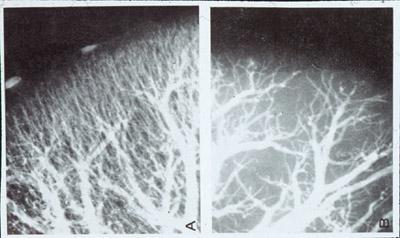Involvement of the kidneys occurs almost exclusively in patients with diffuse scleroderma and is exceedingly rare in limited scleroderma.
The onset of renal involvement in diffuse scleroderma typically occurs in the first 1-2 years during the time when skin involvement is progressively worsening. It is more likely to occur during cold weather months.
What happens?
In the stage before kidney involvement occurs, blood pressure is normal as are standard blood and urine tests that measure kidney function. The onset of kidney involvement is associated with the rapid onset of significant high blood pressure. This causes no symptoms at early stages. If the high blood pressure is not recognized promptly, it worsens rapidly. The kidneys develop damage from the high blood pressure. Blood tests done during this phase show extensive evidence of widespread blood vessel injury with damage to blood cells and evidence of accelerated clotting. This syndrome progresses so rapidly as to be termed “scleroderma renal crisis”. If not recognized and treated early, the risk of kidney failure, the need for dialysis and death are common events.
Pathophysiology
Scleroderma patients with normal kidney function develop blood vessel changes in their kidneys which is very similar to that seen in the fingers, lungs and other organs. In most patients, this damage is silent and does not affect health outcome.
In scleroderma renal crisis, some unknown event triggers blood vessel spasm and additional damage. This triggers aggressive high blood pressure which, in turn, leads to more kidney damage.

The photograph illustrates the blood vessel damage. These are angiograms showing the blood vessel circulation. The kidney circulation on the left shows very regularly distributed blood vessels branching ever smaller likes the roots of a tree. The kidney circulation on the right shows extensive loss of blood vessels associated with scleroderma renal crisis.
The kidney tissue deprived of blood flow ceases to function normally.
Recognition and Treatment
Timing is everything in scleroderma renal crisis. The best approach is to recognize it early by close and frequent monitoring of blood pressure. Patients at high risk - early diffuse scleroderma - should check their blood pressure frequently. Use of a home blood pressure monitoring device is time and cost effective.
Once high blood pressure is recognized, it should be treated promptly and aggressively. One class of antihypertensive medications known as angiotensin converting enzyme inhibitors (ACE inhibitors) (examples – enalapril, captopril, lisinopril) are uniquely effective, although many patients require more than one drug. If the blood pressure can be promptly and completely controlled, kidney injury can be prevented and over time can reverse.
The ACE inhibitors have revolutionized outcomes in scleroderma renal crisis. In the 1970’s, this was universally and rapidly fatal. In 2006, it is frequently managed on an outpatient basis and 60-70% of patients can be treated successfully without sustaining kidney injury.
What can you do?
- If you are a patient at risk, you should learn how to measure your blood pressure and do so at least every other day.
- Certain medications should be avoided or minimized. These include corticosteroids and nonsteroidal anti-inflammatory drugs.
- Caution with cold exposure may reduce the risk.
